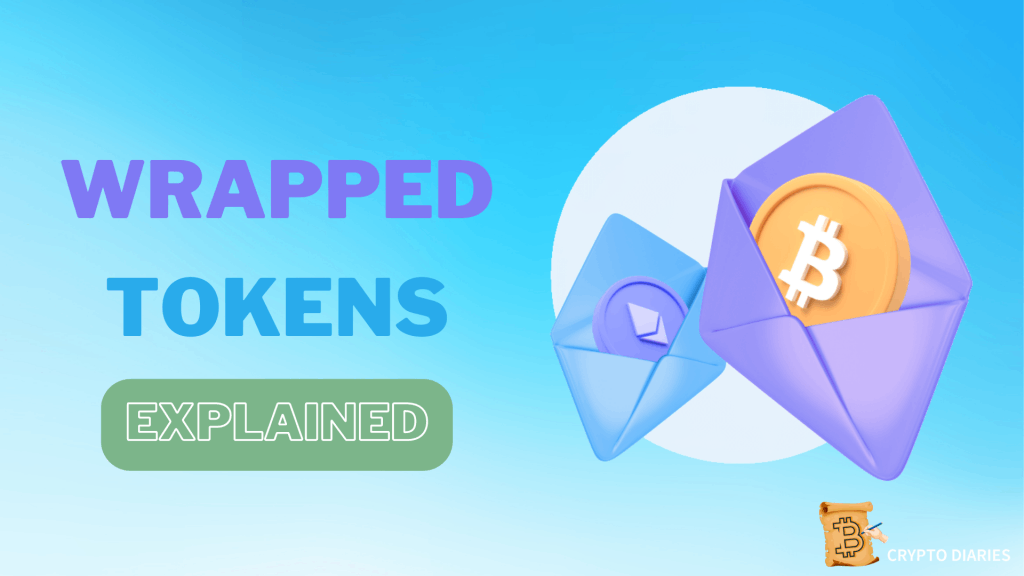Blockchain technology has grown exponentially over the past few years, and more companies are tapping into its potential. However, some limitations still present themselves. Blockchains such as Ethereum and Bitcoin have separate distributed databases; hence they can’t communicate with each other. You can’t use Ethereum on the Bitcoin blockchain because the blockchain only “knows” you have Bitcoin.
Greater interoperability across incompatible cryptocurrencies and blockchains is made possible via wrapped tokens. It makes room for initiatives like lending bitcoin or obtaining ether via DeFi networks. This article will be a deep dive into wrapped tokens, what they are and what they are used for. Let’s get into it:
What is a Wrapped Token?
A wrapped token is an asset that allows the value of a native asset to transfer from one blockchain to another. For example, Wrapped Bitcoin (WBTC) is a popular wrapped token. Since it’s pegged 1:1 to the price of Bitcoin, one Bitcoin will always equal one WBTC. Unlike Bitcoin, WBTC is also available as an ERC-20 token, which makes it an ideal asset for trading on the Tron and Ethereum blockchains.
If you have heard of stablecoins like USDT, wrapped tokens are similar. Since USDT is pegged to the US dollar, it follows the currency’s price. Similar to WBTC, which is pegged to 1 BTC, USDT is pegged to the price of $1.
Wrapped tokens can stand out from other digital assets in their pricing and backing. Hence, ensuring that their value is backed and maintained.
How do Wrapped Tokens Work?
A wrapped token is created and destroyed through minting and burning. For instance, to mint, a WBTC token, the underlying asset, known as BTC, is sent to a custodian. After the custodian has locked the underlying asset away, the equivalent amount of WBTC can be minted. The process is called “wrapping”, where the underlying asset is stored in a digital vault, and the newly minted asset is used on another blockchain.
Although the same process is used to burn WBTC, it is performed reversely. The WBTC token is taken out of circulation, and the equivalent amount of Bitcoin is released from the digital vault.
Burning wrapped tokens is considered to be “unwrapping” the underlying asset. Similar to how a minting process is used to create a token, burning wrapped tokens is done to create a new asset for another blockchain.
All wrapped tokens are backed by an equivalent quantity of their underlying currency due to the minting and burning or wrapping and unwrapping processes. For instance, if a renDOGE token is minted, then 100 DOGE will be held to back the token’s value.
Top Wrapped Token Use Cases
Due to the success of the various cryptocurrencies launched on the blockchain, such as BNB and BTC, there are numerous use cases for wrapped assets. Here are some of the top uses:
Margin Trading
A margin trading system is a type of financial transaction that allows traders to borrow funds from an exchange and use them to make trades. Some cryptocurrencies, such as WBTC, are wrapped and can be used to trade on exchanges.
Yield Farming
With the use of wrapped tokens, investors can earn farm income by participating in the operations of lending and Automated Market Makers(AMMs). They can also receive liquidity pool rewards. In addition to earning farm income, investors can also receive governance tokens from the protocols.
For instance, in the Compound network, investors can receive governance tokens as a reward for helping the platform’s pools maintain their liquidity.
DeFi Lending
Through DeFi lending, a type of financial transaction, investors can earn interest by depositing their assets into various pools. For instance, WBTC can be used to lend Bitcoin through the DeFi lending protocols like MakerDAO and Compound.
Crypto Loan Collateralization
Through crypto collateralization, borrowers access loans on DeFi. This type of loan allows them to use their digital assets as collateral. The amount of crypto held in reserve can pay the loan.
Typically, the collateral used for a loan is provided in Ethereum. However, this type of collateral can expose the Ethereum network to a high risk of volatility. With WBTC as collateral, the network can be maintained at a lower pressure and increase liquidity.
Several protocols already allow you to use wrapped cryptocurrencies as collateral for loans. These include Aave, Compound, and MakerDAO.
What Makes Wrapped Tokens Unique?
Blockchains solve the interoperability issue, a significant issue with the technology’s adoption. Due to the nature of the distributed databases, different blockchains cannot interact seamlessly.
We can now bridge the various blockchains and features currently in existence using wrapped cryptocurrencies. That major development could lead to the widespread adoption of blockchain technology.
What are Some Popular Wrapped Tokens?
With a better scope of wrapped tokens and how they work, you may have come across some but had no idea they were wrapped tokens. Here are some of the wrapped tokens in the market:
Wrapped Bitcoin (WBTC)
The most popular wrapped coin is WBTC. It accounts for over 75% of the market cap of all wrapped tokens. Users can use this version of bitcoin in decentralized applications and DeFi.
WBTC was launched in 2019 by Kyber, Ren, and BitGo. It allows users to participate in the Ethereum ecosystem. You can use it to earn fees and interest as a liquidity provider or lender.
Bitcoin backs the WBTC at a ratio of 1:1. You can wrap it using a merchant such as CoinList. After your transaction, the platform will transfer your bitcoin to a custodian, who will mint an equivalent amount of WBTC.
If you want to redeem your bitcoin, the custodian will either burn it or transfer the original amount to you. At the time of writing, the market capitalization of the WBTC is around $4,661,791,880.
renBTC (RENBTC)
RenBTC is a version of bitcoin that uses a direct supply mechanism to ensure that the value of its currency is maintained. Unlike the previous generation of bitcoin, which relied on a burn to maintain its value, renBTC utilizes a direct supply mechanism.
Its developers launched RENBTC in 2021. It is a cross-chain asset deployment solution that enables the secure and minting of wrapped coins on Ethereum. RenVM acts as the custodian for bitcoin and the corresponding amount of Ethereum coins through this process.
You can redeem your coins by sending them to RenVM and providing them with the equivalent of the old asset. The platform will then destroy the wrapped tokens to maintain the equilibrium price. renBTC has a current market capitalization of $68,858,933.
Wrapped BNB (WBNB)
WBNB is a BEP-20 version of the BNB token that you can use on the BNB Smart Chain. It can be traded on the platform or used to swap for ERC-20 tokens. You can additionally use it on non-native networks such as Terra and Solana.
To complete the BNB token’s life cycle, you can use a BNB asset conversion bridge. Notably, the total market capitalization of the token is $1,149,226,893.
Are Wrapped Tokens Safe?
Generally, yes. The original asset backs a wrapped token, ensuring it will retain its original value. However, if you are holding a wrapped bitcoin, you are not holding it as you don’t have the necessary private keys. That is because, for the token’s smart contract-based wrapping process to work properly, you need to have the necessary private keys.
If something goes wrong during the operation or technical stage of the wrapping process, it could affect access to your assets. That is a risk that people should take even though the issue is yet to receive experience with wrapped tokens.
Existing Limitations of Wrapped Tokens
As we had mentioned, a custodian is required to get the wrapping and unwrapping done. Hence, the funds must be in a trustworthy custodian’s custody.
Although many decentralized options are currently in development, we hope to have a fully trustless system that will allow the redemption and minting of wrapped tokens. One of the main drawbacks of this process is the high gas fees. With the addition of this, the process can be very costly. However, with wrapped tokens, applications can benefit from capital efficiency.
What’s Next for Wrapped Tokens?
The increasing number of blockchains has created a challenge for the industry to ensure that their assets can seamlessly transfer between them. One of the biggest factors the industry looks at is the number of bridges needed to ensure that users can transfer assets seamlessly.
One of the ways to improve the efficiency and ease of connecting assets between blockchains is by using a bridging hub. That is a central hub that connects all of the networks. For instance, Darwinia is a cross-chain bridge hub built on Substrate.
Soon, bridges may be able to join the DeFi market, making it easier to trade wrapped cryptocurrencies in one place. However, it might be so seamless that users will not realize they’re using a bridge or a wrapped token.
Final thoughts
Despite the various technological advancements in the interoperability space, bridges and wrapped tokens will remain an integral part of the solution for a long time.
Although developers can employ various methods to manage wrapped assets, it’s important that investors and traders thoroughly research these types before buying them. Since these types of investments can be volatile, it’s also important to diversify and never invest more than you are willing to lose. That’s a wrap.

